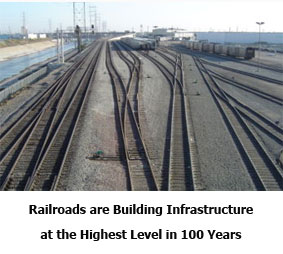(Transportation Management Article - Continued)
As a result, relatively little investment in rail infrastructure was made. That is changing. Lots of people are again “Working on the railroad.”
Volumes have surged, driven by the double-digit annual increases in imports since the late 1990s, as the railroads move containers of offshored goods from US ports to distribution centers further inland. The limited direct rail competition in most lanes means the rail carriers enjoy pricing power – and railroad profits have risen sharply. Billionaire Warren Buffet has taken major stakes in at least three railroad companies on this bullish long-term outlook.
Since 2000, US railroads have invested an estimated $10 billion to add track miles, construct terminals and freight yards, purchase locomotives and cars, and add to IT capabilities to help move all that freight. Some estimates say $12 billion more in upgrades is planned.
In addition to adding track to service new areas of the country, the railroads are also investing in repairing and straightening aging tracks in many areas, enabling the trains to move at much higher speeds along stretches where they currently have to slow dramatically.
Trends Moving in Rail Carriers Favor
 Trucking continues to dominate intercity freight movements, and by most estimates has actually increased its market share since 1990. Trucking accounted for 82% of the U.S.'s truck-and-rail intercity-freight spending in 2004, up from 78% in 1990, according to Eno Transportation Foundation, a research organization in Washington, D.C. The need for speed in the supply chain, combined with smaller shipments sizes, and the steady decline in trucking costs after regulation in the 1980s have helped trucking gain share in tonnage moved. Trucking continues to dominate intercity freight movements, and by most estimates has actually increased its market share since 1990. Trucking accounted for 82% of the U.S.'s truck-and-rail intercity-freight spending in 2004, up from 78% in 1990, according to Eno Transportation Foundation, a research organization in Washington, D.C. The need for speed in the supply chain, combined with smaller shipments sizes, and the steady decline in trucking costs after regulation in the 1980s have helped trucking gain share in tonnage moved.
However, several trends look bright for rail growth:
- Despite a recent slow down, most economists expect strong growth in import volumes to continue over time.
- Many policy experts are looking at increased use of rail as a partial answer to congestion issues on US highways. The recent National Surface Transportation and Revenue Study Commission report specifically called for a broad multi-modal strategy to increasing logistics capacity, and noted the advantages of moving more freight by rail (and waterways). (See The National Surface Transportation and Revenue Study Commission report.)
- Rail will also provide environmental advantages, an increasingly important factor. Environmental concerns may lead some shippers to use rail to reduce their own carbon footprints, and politicians may take action to favor rail movement for similar reasons.
- Though rail carriage is also impacted by rising fuel costs, the effect is somewhat less for rail than for trucking.
Some traditional rail shippers are concerned, however, that current railroad investments are too focused on the needs of importers, and that rates will increase sharply for them to pay for all this building. That includes shippers of things like coal, chemicals, grain, lumber, and other heavy, comparatively low-value products.
"I think the railroads are investing in corridors to serve a different customer, and heavy U.S. industry will be left in the dust," says Kenneth Walker, a transportation manager of Graphic Packaging International Corp., a cardboard manufacturer in Marietta, Georgia, as recently quoted in the Wall Street Journal.
Still, the build out and trends may change transportation dynamics for many companies. Additional service lanes and improved delivery service and consistency will incrementally enable more shippers/importers to use less expensive rail carriage. The new track miles are already causing shippers and third-party logistics companies to build distribution facilities near new or improved rail yards. That’s before factors like environmental-friendliness are considered.
The Wall Street Journal, for example, also says that Method Products Inc., a San Francisco maker of home and personal-care products, plans to use rail for 50% of its shipments this year, up from 33% in 2007, specifically due to environmental concerns. "We view rail as a solution to lower our greenhouse-gas emissions," says Jason Bowman, the firm's global logistics manager.
It seems likely that transportation managers in many companies will need to look harder at the opportunities for increased rail carriage soon.
Do you think the railroad build out will change transportation patterns? What are the barriers to switching to rail? How big a factor might environmental concerns play? Let us know your thoughts at the Feedback button below. |